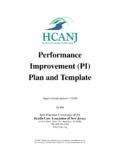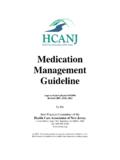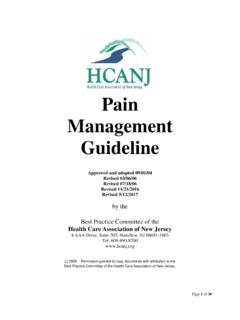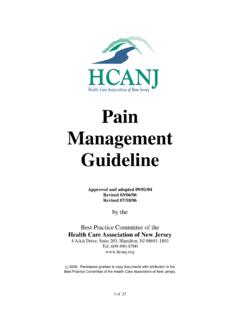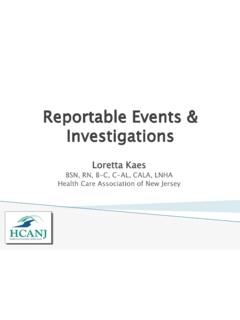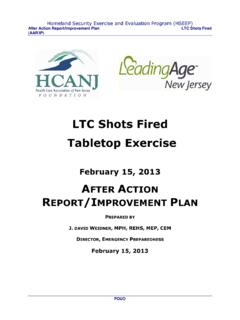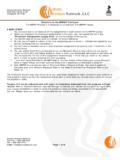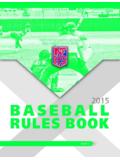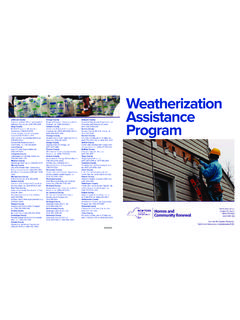Transcription of Responding to Regulatory Requirements & …
1 11/15/2010. Responding to Regulatory Requirements & frequently cited deficiencies in Long Term care Presented by: Ruth West, RN, BS. Director of Regulatory Compliance Healthcare Compliance Group Cell: Office 516. 1. Objectives 1. To provide an overview of the Regulatory Process. 2. To understand & apply the CFR Code of Federal Regulations 3. To prevent deficiencies & understand the Scope and Severity Grid 4. To be familiar with frequently cited deficiencies & ways to prevent them 5. To understand the concept of Resident Centered care & Survey Readiness at the same time! 2. What Do We Need To Know? 1. Long Term care /Skilled Nursing Facilities are governed, regulated & overseen by many agencies! *CMS: Centers for Medicare/Medicaid Services Code of Federal Regulations ( ). *New Jersey State Department of Health & Senior Services New Jersey Administrative Code (NJAC). ( ). 3. 1. 11/15/2010. What Do We Need To Know? *Title 42 of Public Health Code *Office of the Attorney General/Law and Public Safety ( ).
2 *Occupational Safety & Health Administration Protects the Health & Safety of the Healthcare Worker ( ). 4. What Do We Need To Know? *HHS Office of the Inspector General Coordinates all federal agencies, provides publications & reports regarding nursing home inspections. Provides regulations to other authorities: ssFraud & Abuse Law ssCMS. ( ). 5. Other Helpful Websites: *Centers for Disease Control ( ). *The Compliance Store ( ). *American Association of Nurse Assessment Coordinators ( ). 6. 2. 11/15/2010. Overview Of The Regulatory Process 7. What Do We Need to Know ? Definitions/Acronyms 1. F-Tag CFR - code of Federal regulations n There are 183 F-Tags n F means Federal-Tag n Tags start with F150 Residents Rights ends with F522 Disclosure of Ownership 2. SOM - State Operation Manual; all of the above tags can be found in this manual as well as survey documents 3. SNF - Skilled Nursing Facility or NF which meets the Requirements of the Social Security Act . A skilled nursing facility is defined as an institution which is primarily engaged in providing skilled nursing care and related services for residents who require medical or nursing care , or rehabilitation services, and is not primarily for the care and treatment of mental diseases; has in effect a transfer agreement with one or more hospitals.
3 8. What Do We Need to Know ? Definitions/Acronyms (cont'd.). 4. LSC- Life Safety Code, adapted from the NFPA - National Fire Protection Agency- this code is utilized as part of the survey process for compliance with Disaster Plans, Building codes, Fire Prevention, etc. 5. K-Tag - Springs off of the LSC and NFPA and correlates with Requirements of the building code. K-Tags are part of the survey process, and can be cited using scope and severity. 9. 3. 11/15/2010. What Do We Need to Know ? Definitions/Acronyms (cont'd.). 6. Deficiency- failure to meet a participation requirement specified in the Social Security Act or in 42 CFR Part 483, Subpart B. 7. Dually Participating Facility- a facility that has a provider agreement for both medicare and medicaid 8. Immediate Family- husband or wife, natural or adopted parent, child, sibling, step parent, step child, step brother, step sister, father-in-law, mother-in-law, son-in-law, daughter-in-law, brother-in-law, sister-in-law, grandparent or grandchild 10.
4 What Do We Need to Know ? Definitions/Acronyms (cont'd.). 9. Immediate Jeopardy (IJ)- a situation in which the facility's non- compliance with one or more Requirements of participation has cause or is likely to cause serious injury, harm or death to a Resident. (see appendix ( ). 10. Neglect- failure to provide goods and services necessary to avoid physical harm, mental anguish or mental illness. 11. Abuse- the willful inflictions of injury, unreasonable confinement, intimidation or punishment with resulting physical harm, pain or mental anguish. Key Point: The Public Health Code 2803d does not recognize the word willful in their definition. 11. What Do We Need to Know ? Definitions/Acronyms (con't). 12. Misappropriation of Resident Property- the deliberate misplacement, exploitation, or wrongful temporary use of a Resident's belongings or money without the Residents consent. 13. Non-Compliance- any deficiency that causes a facility to not be in substantial compliance.)
5 14. Substantial Compliance- means a level of compliance with the Requirements of participation such that any identified deficiencies pose no greater risk to Residents health or safety than the potential for causing minimal harm. 12. 4. 11/15/2010. What Do We Need to Know ? Definitions/Acronyms (cont'd.). 15. Sub-Standard Quality of care - one or more deficiencies related to participation Requirements under ( ) Resident behavior and facility practices, ( ). Quality of Life, or ( ) Quality of care ; which constitute either immediate jeopardy to Resident health or safety, a pattern of or widespread actual harm that is not immediate jeopardy, or a wide spread potential for more than minimal harm, but less than immediate jeopardy with no actual harm. 16. Enforcement Action- The process of imposing one or more of the following remedies: termination of provider agreement denial of participation denial of payment (DOPNA). temporary manager civil money penalty state monitoring Directed Plan of Correction Directed Inservice Training transfer of Residents closure of facility other CMS approved/state remedies 13.
6 Who Does What? 1. DOH is contracted by CMS to provide the Survey Process 2. DOH surveys facilities, however, it is a Federal Survey process that is utilized 3. CMS can also provide Regulatory Surveys: 1. To monitor performance by the DOH. 2. To respond to complaints, and or concerns triggered by numerous sources 14. I. Survey Cycle n Surveys are done to ascertain compliance with Federal and State codes (called conditions of participation). n Survey cycle can be 9-15 months, but must be done annually n Facilities should adopt the concept of being Survey Ready everyday! 15. 5. 11/15/2010. II. Types of Survey: A. Standard Survey- periodic resident centered inspection which gathers information about the quality of service provided in a facility to determine compliance with the Requirements of participation. Usually done annually. B. Abbreviated Standard Survey- Other than a standard survey, resident centered on Facility compliance. May result from a compliant, change of ownership, management, DNS or any other indicator C.
7 Extended Survey- A survey that evaluates additional participation Requirements subsequent to finding Substantial Quality of care during a standard survey 16. II. Types of Survey D. Partial Extended Survey- A survey that evaluates additional participation Requirements subsequent to finding Substantial Quality of care during an Abbreviated Survey E. Validation Survey- (commonly known as Comparative Survey) usually conducted within 2 month following a standard, abbreviate, partial extended, extended for the purpose of monitoring state agency performance (this is usually a Federal Survey). F. Other- The Survey Agency (State or Federal). may conduct a survey as frequently as necessary to confirm the facility corrected deficiencies 17. What Do We Need To Know Con't? How are deficiencies cited ? *The Scope and Severity Grid is used in all states! SCOPE: number of residents or staff involved in a deficient practice. SEVERITY: level of harm or outcome of the deficient practice.
8 18. 6. 11/15/2010. Scope and Severity Grid Scope Levels: Isolated, Patterned or Widespread levels Severity Levels: (1) No actual harm (2) No actual harm with potential for more than minimal harm (3) Actual harm (that is not immediate jeopardy) (4) Immediate Jeopardy 4. J K L. 3 G H I. 2 D E F. (Substandard QOC). 1. A B C. 19. ISOLATED PATTERNED WIDESPREAD. OVERVIEW OF. frequently cited . F-TAGS. & COMPLIANCE TIPS 20. Involved F-Tags n F279 284 care Planning n F221 Restraints n F223 226 Abuse Protocols n F309 Quality of care /. Pain Management n F314 Pressure Sores n F323 Hazards/accidents n F441 Infection Control n Of mention: F252 Environment F253 Housekeeping 21. 7. 11/15/2010. F279 284 care Planning o Among the top 10 deficiencies cited in all Facilities! Can be a Domino effect for other deficiencies . o Frequent deficient practice includes: Not developing a plan/Plan not specific or individualized Not revising the plan Not implementing the plan Not interdisciplinary Not evaluating the plan Goals not measurable Not developing a discharge plan (F283/F284).
9 Not implementing a discharge plan to Resident or Family care Plan NOT compatible with CAA'S) ( care Area Assessments). 22. Compliance Tips . care Planning * care Plan deficiencies are the most preventative if your team follows guidelines for compliance! *Develop the Philosophy that care Planning begins on day of admission and ongoing *Develop care Plan concepts and assignments in your morning meeting. *Utilize the 24 hour report as a means of CCP. communications to other disciplines. 23. Compliance Tips care Planning o Make it a mandatory policy that all department heads and key care givers read and respond to the 24 hour report: Same should be done at morning meeting (CCP/QA). Concentration should be on quality care issues Minutes and attendance should be taken for validation Assignment for follow-up and care planning should be done at the meeting or via 24 hour report shift shift Have disciplines sign the 24 hour report as well as morning meeting attendance for validation and awareness or develop 24.
10 A Morning Meeting report form 8. 11/15/2010. QA/CCP. Morning Meeting: Date_____. Attendance: _____ _____. _____ _____. _____ _____. _____ _____. Potential Quality Action Plan Assigned Outcome Issue Discipline 331 John Smith: 1. Medical work up RN/MD. Developed new stage II including serum P/S on left buttock, and albumin lost 2 lbs. 2. Dietary RD. evaluation Wound care 3. To be seen by Nurse wound care team 3/5/09. 25. Compliance Tips . care Planning o Include CCP Review in all Quality of care audits as part of overall QA for compliance. o care Plan Policies and Protocols should be part of overall orientation to involved disciplines on initial hire and throughout the year! Inservice should concentrate on revision of the plan! o Consultants should be part of the CCP team including overall QA or documentation: Pharmacy Consultant review CCP's as part of overall review. Infection Control compliance and plans for infection Psychologist care plan interventions in case notes or on CCP.
